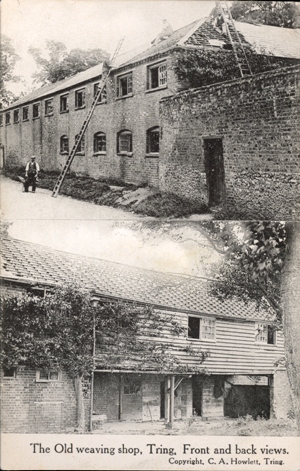A quick scan of the
Militia List for Tring
(published by the Herts Family History
Society, and covering the period 1758 to 1786) shows there were quite a
lot of weavers in Tring, throughout the
period covered by the lists. Normally the word was not expanded to say what they
were weaving but a couple are described as "Sack Weavers" and other
references (with earliest date) are to "Flax Dresser" in 1759,
"Hemp Dresser" in 1758 and "Hemp Man" 1778. There were also a
few references to Rope Makers, who would presumably also used hemp. Two members of the Cato
family were weavers between 1772 and 1783, as was a member of the Cutler
family. Members of the Olney family were
also weavers between 1772 and 1786. This could well suggest that canvas weaving
was well under way at Tring by about 1770.
The Centre for Buckinghamshire Studies hold records of Messrs Grace
of Tring, corn and seed merchants, maltsters,
millers, etc. "... Upon his retirement the business was carried on by
his daughter Anne and son-in-law Thomas
Grace. Although the opening of the Grand Junction Canal in 1800 had
put an end to the milling trade a number of other enterprises were pursued. Carter
and Grace were maltsters, corn merchants,
bakers, coal merchants, and canvas weavers. This last
business was perhaps inherited from Thomas Grace's
father, who was described as a weaver, and was sold in the mid nineteenth
century to a Mr. Cato. ..." It
would appear that the records held in the Centre contain information on the
canvas weaving business. [from
Access
to Archives web site.]
In the 1828/9
Pigot's
Directory four canvas weavers were listed in Tring.
They were George Cutler, - Langdon,
Daniel Olney and Harding
Olney.
In 1831 canvas weaving (along with the silk mill and straw plait)
was important enough to be mentioned in the Tring
entry to S. Lewis's The Topographical Dictionary of England.
In the 1839 Pigot's
Directory four Canvas manufacturers are listed for Tring.
They were William Cato (Akeman
Street), George Cutler (Frogmore
End), Daniel Olney (Dunsley)
and William Olney (Akeman
Street).
In the 1846 Post Office
Directory for Herts there were 4 canvas manufacturers in Hertfordshire
- all in Tring. They were Wm
Cato (West End), Geo.
Cutler (Frogmore End), Danl
Olney (Dunsley End) and Wm
Olney (& brewer, Akeman Street).
In the 1851 directory only William Cato
and Daniel Olney are listed - and in the
(incomplete) 1851 HFHS census CD eleven
canvas weavers are listed - all in Tring,
with only William Cato being listed as an
employer.
In 1866 there are only two canvas manufacturers in the whole of Hertfordshire.
These are J Burgess, Canvas Manufacturer, Lower
Dunsley, Tring, and W. Cato,
canvas manufacturer, open canvas manufacturer & open canvas for berlin wool
& gunpowder canvas manufacturer, West End, Tring.
|

The Old Weaving Shop
in Park Road, Tring
Copyright C A Howlett, Tring |
In the 1890
Kelly's
Directory the only two canvas manufacturers listed in Hertfordshire were
Charles Cato, Charles
Street, Tring and George Cato, Park
Road, Tring.
The book
Around Tring
has a picture of Cato's weaving shop in
Park Road in the 1890s and says "There were several weaving shops in Tring,
making rough canvas for items such as horse nosebags through to fine canvas used
for embroidery. Cato's started originally in
Tabernacle Yard in
Akeman Street but George Cato
later ran his business from 12 Charles Street,
The premises in Park Road employed a lot of
young boys who were 'half-timers' from school. The building was later demolished
as part of the Rothschild's clearance of the south side of Park
Road."
The 1902 directory reports for Tring
that "The business of the town consists chiefly in canvas weaving, straw
plaiting and brewing" and lists Charles Cato,
12 Charles Street, and George
Cato, Park Road, as the only
canvas manufactiurers in Hertfordshire.
In the 1912 Kelly's
directory the only canvas manufacturer in Hertfordshire
was Charles Cato, 12
Charles Street, Tring. None were listed in the 1922 directory.
To conclude, it would seem that canvas weaving was a notable
local industry in Tring from the mid-18th
century or
earlier until the First World War. Obviously more information could be added on
individual workers from the 1841-1901
census
returns.
George
CUTLER, Canvas Weaver, Tring
Ted Cutler (Cutlerted
@t aol.com) writes: I have come across details of a forefathers George
Cutler's will dated 1845. According to the London
- Birmingham train guide held in
HALS
he was the largest Canvas Manufacturer in Tring
with 100 employees. Is shown in
Pigot's
from 1824 onwards. The will shows the family connection with the Fleet
family (they are buried next to each other in Akerman
Street Baptist church). Geo.
owned properties in Akerman Street as well
as Frogmore Street and I believe Lower
Dunsley. Frogmore is shown in the
will as the Canvas Manufactory and also a Common Brewery with a freehold house
adjoining. I think his late wife Rebecca Tomkins
was a daughter and niece of two of the largest publicans in the town.
Page updated December 2008